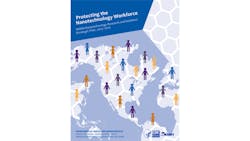NIOSH Updates Strategic Plan for Protecting Nanotechnology Workers
NIOSH has issued an updated strategic plan for protecting workers in applications involving nanotechnology. “Protecting the Nanotechnology Workforce: NIOSH Nanotechnology Research and Guidance Strategic Plan, 2013–2016” updates the agency’s 2009 strategic plan “with knowledge gained from results of ongoing research,” NIOSH says.
While nanotechnology “offers the potential for tremendous improvement and advances in the development of commercial products that may benefit society,” the unique properties of engineered nanoparticles also could pose health risks to workers, the agency explains in the strategic plan.
“Increasing numbers of workers are potentially exposed to nanomaterials in research laboratories, startup companies, production facilities and operations where nanomaterials are processed, used, disposed or recycled,” the agency explains in the plan. “The challenge is to determine whether the nature of intentionally produced (engineered) nanostructured materials and devices presents new occupational safety and health risks. At the same time, there is a need to address how the benefits of nanotechnology can be realized while the risks are proactively minimized.”
The NIOSH strategic plan defines nanotechnology as “a system of innovative methods to control and manipulate matter at near-atomic scale to produce new materials, structures and devices.” The National Science Foundation predicts that the global market for nanotechnology-related products will reach $3 trillion and employ 2 million workers in the United States by 2020.
“Today, nanomaterials are found in hundreds of products, ranging from cosmetics to clothing to industrial and biomedical applications,” NIOSH says. “The potential benefits of nanotechnology are huge, and these benefits should be realized by society. However, there is ongoing concern that the full potential of the societal benefits may not be realized if research efforts are not undertaken to determine how to best manage and control the potential occupational safety and health hazards associated with the handling of these nanomaterials.”
NIOSH notes that its strategic plan “is the roadmap being used to advance basic understanding of the toxicology and workplace exposures involved so that appropriate risk-management practices can be implemented during discovery, development and commercialization of engineered nanomaterials.”
